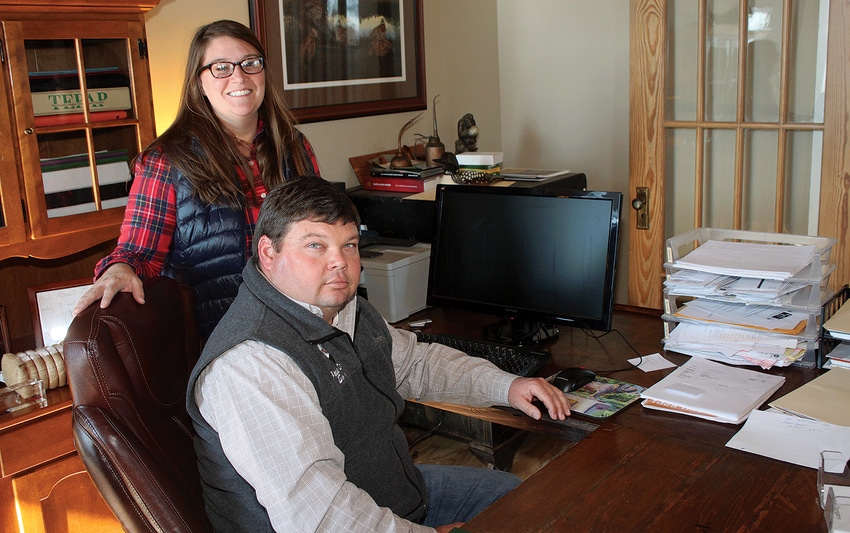
When Brad Judson received his agricultural business/economics degree from Mississippi State University, he didn’t have a family farming operation to which he could return.
His father had got out of farming in the 1980s, when Brad was about 10. “I had some early exposure to the farming life,” he says, “and during high school and college, I worked for a farmer, the late Russell Rardin. When I finished at Mississippi State, he asked me if I had any interest in farming myself.
“‘Yes,’ I said, ‘but I don’t have any land or equipment.’ He was looking toward retirement and said he would help me get started. I was able to take over some of his leases, plus some land that family members were farming, but wanted to get out.
“My first crop was in 2001, about 800 acres, all dryland. Soybeans were $4 to $5, and everyone told me, ‘You’re going to lose everything.’ But I didn’t have a lot to lose, and I was determined to make it work.”
Today, Brad and his wife, Molly, farm some 3,000 acres in Clay, Monroe, and Lowndes counties in the black prairie region of east central Mississippi, and he has been named one of the ten finalists for the national Outstanding Young Farmer Award. The winner will be announced in February at the national convention in Greenville, S.C.
The award was founded by the U.S. Junior Chamber of Commerce (Jaycees), is administered by Outstanding Farmers of America, supported by the National Association of County Agricultural Agents, and sponsored by John Deere.
“In an era when the average age of the U.S. farmer is pushing 60 years, it’s inspiring to see young farmers like Brad and Molly getting a foothold in the business and becoming successful,” says Charlie Stokes, Mississippi State University Extension area agronomy agent at Aberdeen, Miss., who nominated Brad for the award.
Brad and Molly Judson with Charlie Stokes, back left, Mississippi State University Extension agronomy agent, who nominated Brad for the national award, and farm employee Seth Todd.
EXPANSION CHALLENGING
Brad, who laughingly says he “just squeaked under” the 40 years age limit for the competition, says, “One of the biggest challenges as a farmer in this part of the state is finding more land. I’ve been fortunate over the past 15 years to gradually acquire additional acreage.” He now has 14 farms total, the farthest about 30 miles away; the smallest is 90 acres, the largest 450 acres. He owns about 800 acres, and leases the rest.
Along the way, he’s also acquired a lineup of modern equipment and added four Zimmatic center pivot systems, which are fed from reservoirs that range in size from 25 acres to 40 acres. One pivot covers 180 acres, another 315 acres, and the two others cover 160 acres. He can irrigate about 21 percent of his acreage.
“Drilling wells is prohibitively expensive — you have to go 1,000 feet or more to get water,” he says, and irrigation lakes are common in the region. The pivots came in handy this past year. “We only had one good rain during the entire season,” he says. “But the reservoirs had adequate water for irrigation. At the end of the season, there was still enough water remaining for another couple of turns with the sprinklers, had further irrigation been needed.” The lakes are filled by rainfall, but one of them can be supplemented with water from a nearby creek, if necessary.
There are a power lines on some of his farms that somewhat limit potential for further irrigation, but Brad says, “We hope to add more pivots as we move ahead. The challenge is not putting pivots up — it’s getting water for them, and taking land out of production to build reservoirs.”
All the pivots operate with FieldNet controllers, and can be monitored remotely by cell phone or iPad. “All our workers have apps on their cell phones, so if they need to move a pivot for spraying or fieldwork, they can easily do so,” he says. All the pivots are electric-powered. “They cost more initially, but the operating cost with electricity is much less.”
He uses soil moisture sensors to help properly time irrigation, and fertigation pumps to make timely fertilizer applications through the pivots to help improve yields.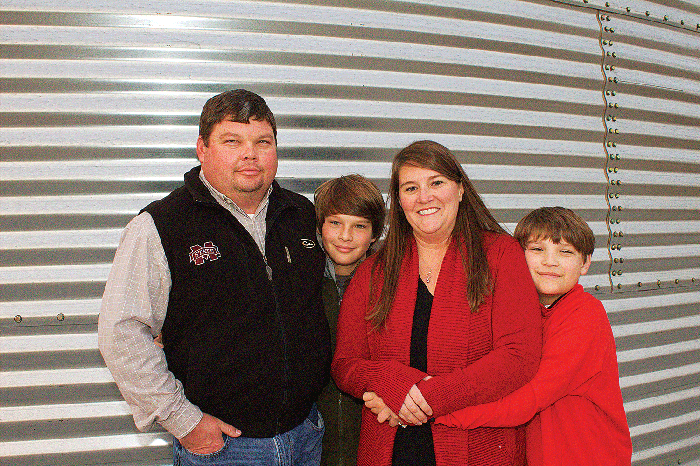
The Judson family, from left, Brad, Hamp, Molly, and Howie. There are seven grain storage bins on the farms, with 115,000 bushels of capacity.—Photo by LaTrell Stokes
2016 CROP LINEUP
In 2016, Brad had 1,300 acres each of corn and cotton, and 400 of soybeans (300 of that double-crop). “The corn wasn’t so good,” he says. “We normally average 150 bushels, but that dropped to 125. We averaged almost 1,200 pounds on cotton — some of the irrigated cotton yields were just unreal. Even on the dryland acres, with just one rain, yield was really good. Better varieties have really made a difference in cotton production.
“Soybeans averaged only 25 bushels, compared to 50 bushels or better the previous three years. On these prairie soils, soybeans are so inconsistent we can’t count on a good return, even with irrigation, so we rotate cotton and corn under the pivots. If we have a summer with relatively cool nighttime temperatures and decent rains, we can get good soybean yields, but if it’s hot and dry, as it was in 2016, they drop off considerably. We can pretty much count on cotton and corn.’
In 2016, his cotton varieties were DP 1133 B2RF, 1555 B2RF, 1522 B2XF, and 1321 B2RF; corn, Dekalb 6697, 6208, 6757, and AgVenture 9745; soybeans, Asgrow 4632 and AgVenture 5108.
Thus far, he says, he’s had no problems with resistant pigweeds, “but they’re in the area. We try to stay on top of things with residuals. If we have trouble spots in corn, Lexar will usually take care of them. For cotton, we plant with Roundup and Cotoran; then, one in-season Roundup application will usually get us to lay-by with Roundup and Valor. On soybean ground, we apply Roundup and Valor at planting, then two in-season applications of Roundup. One or two fields might need an application of Reflex. If I spend money on the front end and start out clean, I have fewer problems later in the season.”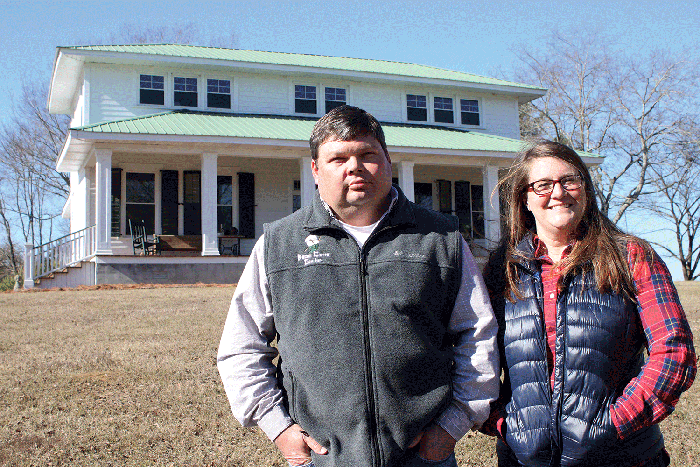
This restored 1860s house, overlooking a lake and surrounding farmland, serves as the office for Brad and Molly Judson's farming operation, as well as for family getaways and events.
ROUND BALE HARVESTER
He has mostly a John Deere equipment lineup, including a 7760 round bale cotton harvester, acquired in 2013. “It’s an expensive piece of machinery, granted,” Brad says, “but when you look at the savings in manpower, time, and additional support machinery needed with the old module system, it’s a no-brainer. Cotton harvesting is now basically a one-man show. This machine allows us to get the crop out have time to get fieldwork done in the fall.
“We row up every acre in the fall, and make our own precision fertilizer applications, based either on replacement values, or whatever we need to do based on soil samples and yield maps. Dry fertilizer is banded in-furrow. We have a Montag fertilizer cart combined with a chisel plow that allows us to rip, apply fertilizer, and bed up all in one trip. It’s very efficient and saves a lot of time. When spring comes, we have fertilizer already down and the ground already bedded up. We just burn down, usually with Roundup and LeadOff, and plant on 30-inch rows.” He has a John Deere R4030 sprayer with controllable application technology.
“We have two 12-row planters, one with a precision system and electric drives for prescription seeding. I’m going to analyze the results from last season to see if I can justify purchasing another of the precision systems.”
He relies on industry sources, private consultants, and Extension personnel to help with variety selection and in-season crop management recommendations.
His combine is a John Deere 9770. “We’re a bit tractor heavy right now,” he says, ”but we seem to find use for all of them. We have John Deere 8330, 8295R, and 8310 R tractors, and a Case 380 Magnum with half tracks. Compaction can be a problem on our clay soils and I’m hoping the Magnum will help reduce that. I’ve been really impressed with it so far — it’s a versatile machine with a lot of pulling power.”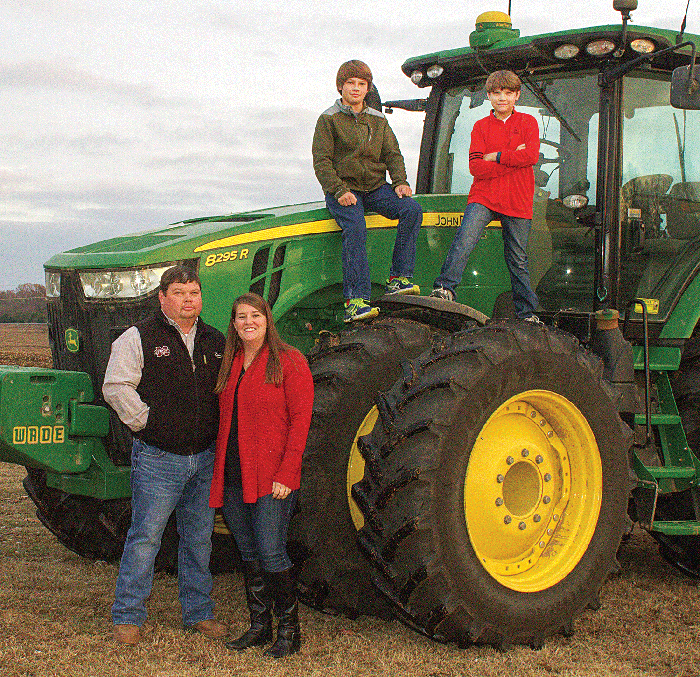
The Judson family with one of the farm's John Deere tractors: Brad and Molly and sons Hamp and Howie.—Photo by LaTrell Stokes
NEW COTTON GIN
Brad is a stockholder and on the board of directors of the Bogue Chitto Gin that was built near Macon, Miss., four years ago. “Business has just exploded,” he says. “Seventy-five percent of the business is within 25 miles of the gin, but we’re now ginning cotton from as far south as Hattiesburg, Miss., and as far north as Tupelo, Miss.” There are discussions, he says, about adding another gin stand for the 2017 ginning season.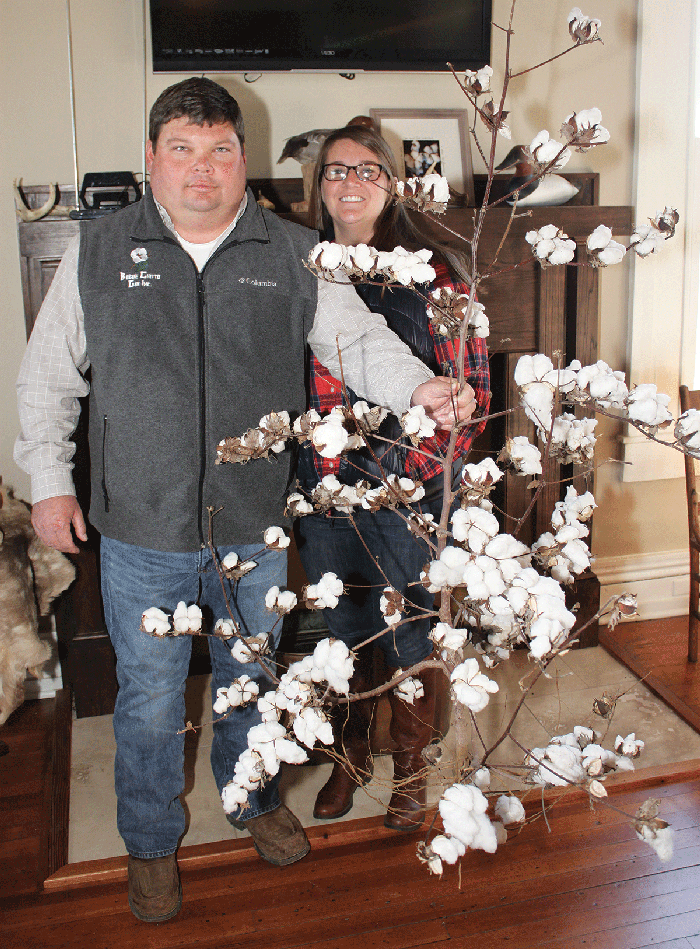
Brad and Molly Judson display a cotton stalk loaded with bolls top to bottom. Some yields on 2016 cotton "were unreal," says Brad.
Cotton is marketed through Lee Thompson at Mooreville, Miss., and grains through Tom Soya Grain or Prestage Farms, both at West Point, Miss., or Peco Foods at Gordo, Ala. He has seven storage bins, with 115,000 bushels of capacity. “I’ve purchased a continuous flow dryer that will be installed in time for the 2017 crop,” he says.
Brad has worked with the Natural Resources Conservation Service on several Environmental Quality Incentives Program projects to help control soil erosion & water quality. “We plant wheat on a lot of ditch banks, row ends, and other areas that are subject to erosion. We don’t have a full cover crop system in place yet, but next year we hope to plant more cover crops — wheat, oats, or rye.”
Deer can be a problem on some of his land. “About 400 acres are pretty much off limits for soybeans because of deer. So far, we’ve dodged a bullet with wild hogs, although they’re all around us.”
Brad serves on the Clay County Farm Bureau Board, and is a commissioner for the Clay County Soil and Water Conservation District Board. The family attends First United Methodist Church at West Point.
“I have been blessed to be able to make a living in farming, and purchase equipment and other assets,” Brad says. “Our sons, Hamp and Howie, help out with chores around the farm, and Hamp drove a tractor during wheat harvest.
“If either or both of our boys want to pursue farming one day, I hope to have the operation to the point that it will be capable of supporting them — but only if that’s what they want to do; I don’t in any way want to try and dictate their lives for them.”
Molly adds: “We can’t say enough for our farm employees. All are extremely capable and dependable, and we’re grateful to have them as a part of our operation.”
About the Author(s)
You May Also Like




